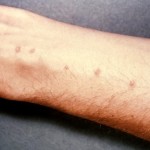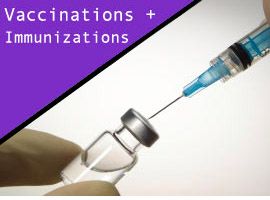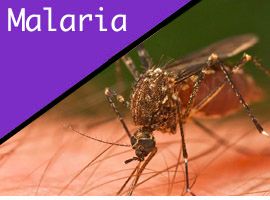According to the Carter Center, “in terms of socioeconomic and public health impact, schistosomiasis, also known as bilharzia or snail fever, is second only to malaria as the most devastating parasitic disease in tropical countries.” 207 million people worldwide are infected with Schistosomiasis.
Thankfully, it is also one of the most avoidable diseases for travelers.
What is Schistosomiasis?
Schistosomiasis is a disease caused by a parasitic worm. It works as follows:
- An infected person passes the eggs of the worm into a water source via fecal matter.
- The eggs hatch and the larvae take up residence in fresh water snails.
- Inside the snail, the parasite begins to produce thousands of cercariae, tiny larvae that will then seek out a human host.
- The cercariae find their way to the skin of bathing or swimming humans (they are attracted to chemicals secreted by our skin).
- Once they penetrate the skin, the cercariae find a blood vessel and travel to the lungs, then the liver.
- At this point, the cercariae have become a worm and once they arrive in the liver, they will develop an oral sucker, which they will use to feed on red blood cells (not what you wanted to hear, we know).
- Different species of the worm will move to different parts of the body, some taking up residence in the bladder or kidneys. After feasting on your red blood cells for a period of 6-8 weeks, the worm will begin producing eggs.
- The eggs will make their way through blood vessels to the intestines where they will eventually leave the body as fecal matter.
- Some of the eggs will not make it out of the body. They will get trapped in blood vessels near the small intestine or they will end up back in the liver. It is then, as your body’s immune response is triggered to do battle with the eggs, that many of the symptoms of schistosomiasis will emerge.
Where is schistosomiasis (bilharzia) found?
Africa, the Middle East, the Caribbean, Brazil, Venezuela, Suriname, China, Indonesia, the Philippines, Several districts of Cambodia and the Lao People’s Democratic Republic.
What are the symptoms of schistosomiasis (bilharzia)?
 Many of the symptoms are similar to giardiasis or amoebic dysentery. Like giardiasis, there are cases where schistosomiasis is largely asymptomatic with signs of anemia and malnutrition showing up over time. In some cases, acute schistosomiasis develops and causes abdominal pain, diarrhea, coughing, fever, fatigue, an enlarged liver and spleen and an elevated white blood cell count. Genital sores and papular dermatitis are also a possibility (papular dermatitis refers to the small pimple like bumps that occasionally form on the skin where the larvae enter the body – see the photo to the right). If acute schistosomiasis persists, fibrosis (the process in which an excessive amount of connective tissue forms) is possible in the affected organs.
Many of the symptoms are similar to giardiasis or amoebic dysentery. Like giardiasis, there are cases where schistosomiasis is largely asymptomatic with signs of anemia and malnutrition showing up over time. In some cases, acute schistosomiasis develops and causes abdominal pain, diarrhea, coughing, fever, fatigue, an enlarged liver and spleen and an elevated white blood cell count. Genital sores and papular dermatitis are also a possibility (papular dermatitis refers to the small pimple like bumps that occasionally form on the skin where the larvae enter the body – see the photo to the right). If acute schistosomiasis persists, fibrosis (the process in which an excessive amount of connective tissue forms) is possible in the affected organs.
Avoiding and preventing schistosomiasis (bilharzia)
– Avoid swimming in freshwater in countries where schistosomiasis is endemic (see above for countries where schistosomiasis can be found). In some cases, it is safe to swim in freshwater rivers, lakes and pools fed by waterfalls, but make sure to ask around in that area to find out if the water is free of schistosomiasis/bilharzia.
– If you do somehow have a monumental brain lapse and you find yourself swimming in a fresh water lake where schistosomiasis is present, get out as quickly as possible and use a towel to vigorously dry your body.
– Drink treated and purified water. Schistosomiasis cannot be caused by eating or drinking anything, but it’s possible for the larvae to enter in through your lips when you are taking a drink. Make sure your water is filtered and purified by either buying bottled water or treating water yourself. For information on treating and purifying water, see our article 4 ways to treat water when traveling or our steripen video review and demonstration (we recommend the steripen as the best water treatment option for travelers).
How to treat schistosomiasis (bilharzia)
If you are experiencing any of the above symptoms and you have recently been swimming or bathing in fresh water, you should go to a clinic for an official diagnosis. Treating schistosomiasis is incredibly straightforward. One single oral dose of praziquantel, an anthelmintic (anthelmintics are a class of drugs that rid parasitic worms from the body), is often enough. If you have acute schistosomiasis, a doctor may prescribe additional doses over time. Untreated, schistosomiasis worms will often live in the body for 4-4.5 years. It is thought that they can last up to 20 years in the human body. Let’s be thankful for praziquantel.
There are, however, instances where treatment is difficult due to ongoing infection. We have one reader that actually wrote about this experience here.
Have you had schistosomiasis (bilharzia) before? Or do you know someone that has? Let us know about it in the comments.












{ 83 comments… add one }